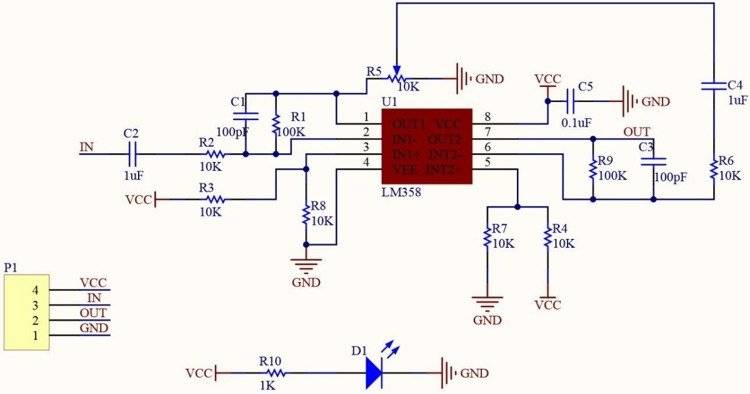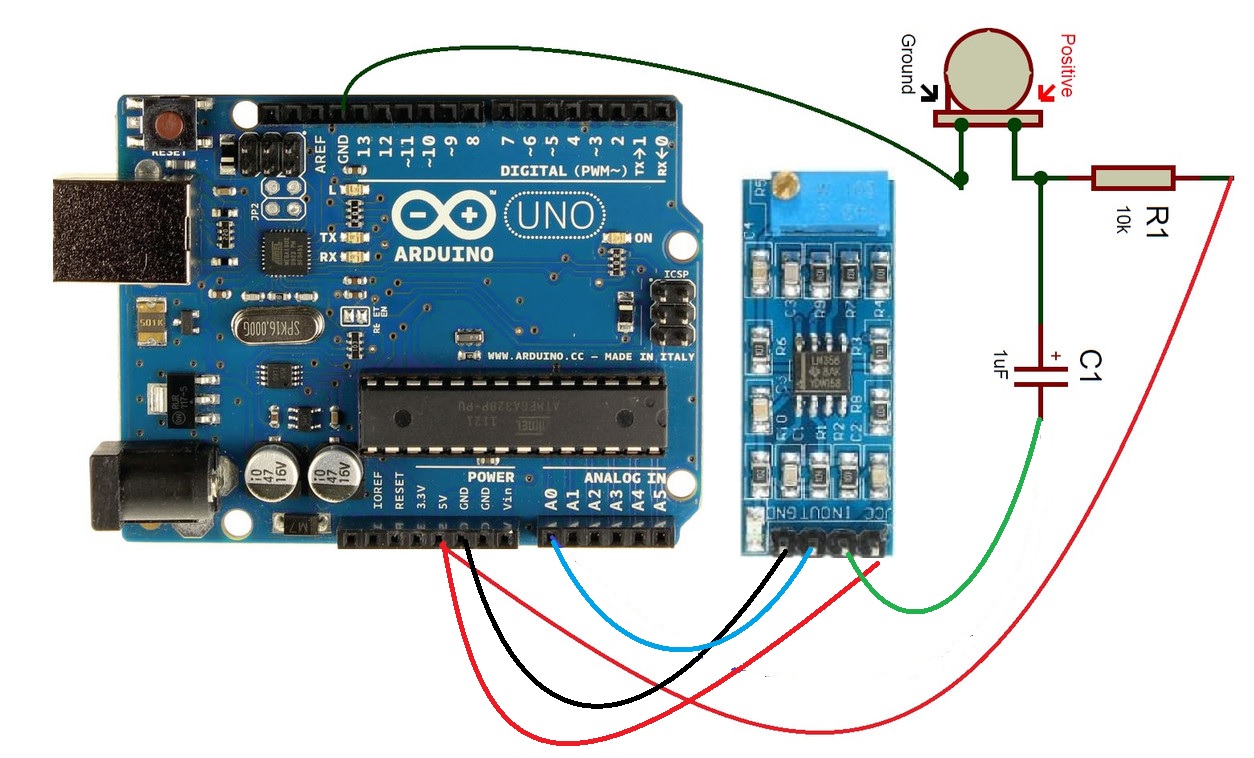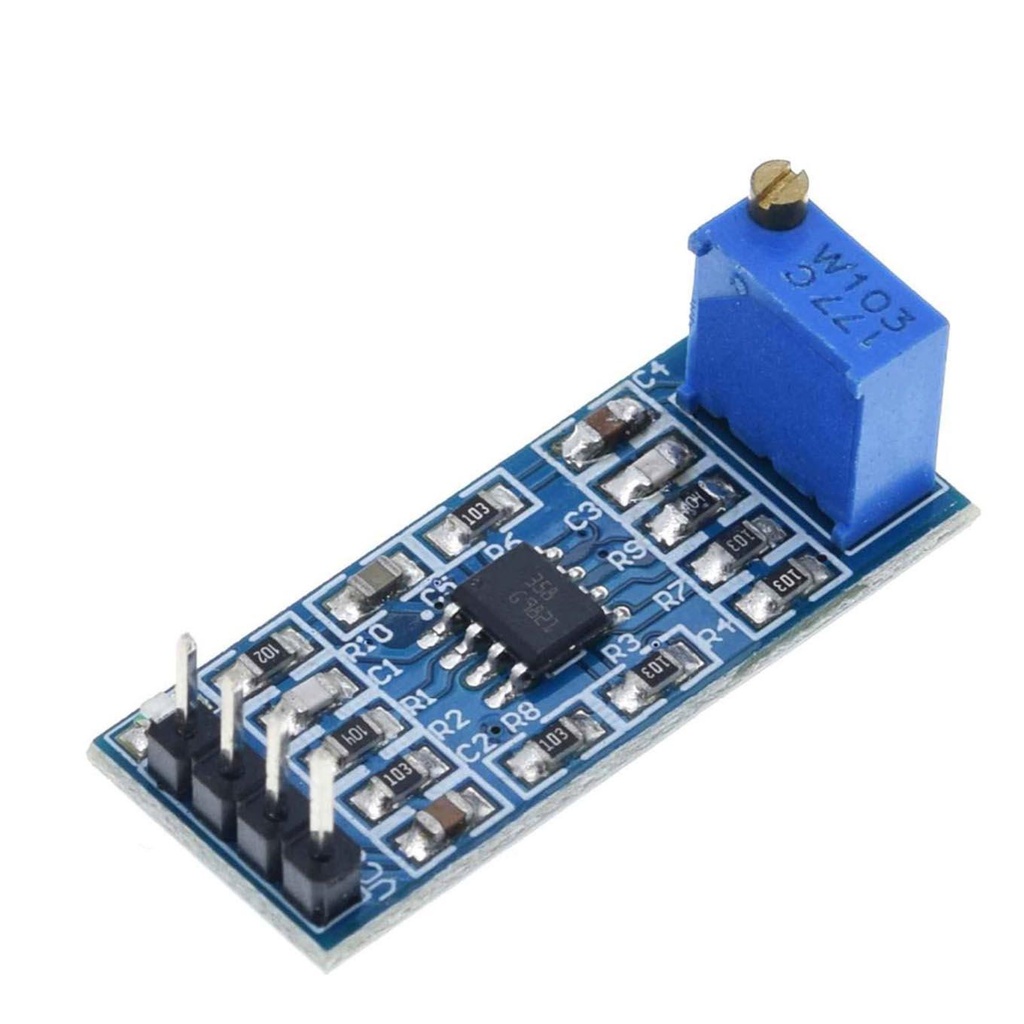Features:
- Based on LM358 operational amplifier chip
- Adjustable gain up to 100x using onboard 10K potentiometer
- Built-in power indicator LED
- Direct signal input/output via breakout pins
- Compact design for easy integration into projects
Specifications:
- Supply Voltage: 5V – 12V DC
- Gain: Adjustable from 1x to 100x
- Module Dimensions: 32.7mm × 13.3mm
- Max Sink Current: 20mA
- Max Source Current: 30mA
- Bandwidth: 700kHz
Pinout Description:

- VCC: 5V – 12V power supply input
- IN: Analog signal input
- OUT: Amplified analog output
- GND: Ground
Principle of Operation:
The module uses the LM358 op-amp to amplify incoming analog signals such as audio or sensor data. Apply 5–12V to the VCC pin, feed the analog input to the IN pin, and retrieve the amplified signal from the OUT pin. The gain can be adjusted by rotating the onboard potentiometer: turning it counterclockwise increases gain, and clockwise decreases it.

Applications:
- Microphone preamplifier
- Sensor signal conditioning
- Alarm systems and light meters
- Sound detection with Arduino
Example Circuit:
This module can be used with a 9x7mm microphone (sold separately) to build a sound detector circuit. Connect the microphone output to the amplifier input, then connect the amplifier output to an Arduino analog pin (e.g., A0). Power the module from the Arduino’s 5V and GND.

Arduino Example Code:
const int sensorPIN = A0;
const int sampleWindow = 50; // 50 ms = 20 Hz
void setup() {
Serial.begin(9600);
}
void loop() {
unsigned long startMillis = millis();
unsigned int signalMax = 0;
unsigned int signalMin = 1024;
unsigned int sample;
while (millis() - startMillis < sampleWindow) {
sample = analogRead(sensorPIN);
if (sample < 1024) {
if (sample > signalMax) signalMax = sample;
if (sample < signalMin) signalMin = sample;
}
}
unsigned int peakToPeak = signalMax - signalMin;
double volts = (peakToPeak * 5.0) / 1024;
Serial.println(volts);
}
Library:
No external library is required for this module.
Comparison with LM393:
| Specification |
LM358 (Op-Amp) |
LM393 (Comparator) |
| Supply Voltage |
32V, ±16V |
36V, ±18V |
| Differential Input Voltage |
32V |
36V |
| Input Offset Voltage |
3mV max. |
5mV max. |
| Input Bias Current |
100nA max. |
250nA max. |
| Input Common Mode Range |
0V to V+ − 2V |
0V to V+ − 1.5V |
| Large Signal Voltage Gain |
100V/mV typ. |
200V/mV typ. |
| Bandwidth |
1MHz |
Not specified |
Features:
- Based on LM358 operational amplifier chip
- Adjustable gain up to 100x using onboard 10K potentiometer
- Built-in power indicator LED
- Direct signal input/output via breakout pins
- Compact design for easy integration into projects
Specifications:
- Supply Voltage: 5V – 12V DC
- Gain: Adjustable from 1x to 100x
- Module Dimensions: 32.7mm × 13.3mm
- Max Sink Current: 20mA
- Max Source Current: 30mA
- Bandwidth: 700kHz
Pinout Description:

- VCC: 5V – 12V power supply input
- IN: Analog signal input
- OUT: Amplified analog output
- GND: Ground
Principle of Operation:
The module uses the LM358 op-amp to amplify incoming analog signals such as audio or sensor data. Apply 5–12V to the VCC pin, feed the analog input to the IN pin, and retrieve the amplified signal from the OUT pin. The gain can be adjusted by rotating the onboard potentiometer: turning it counterclockwise increases gain, and clockwise decreases it.

Applications:
- Microphone preamplifier
- Sensor signal conditioning
- Alarm systems and light meters
- Sound detection with Arduino
Example Circuit:
This module can be used with a 9x7mm microphone (sold separately) to build a sound detector circuit. Connect the microphone output to the amplifier input, then connect the amplifier output to an Arduino analog pin (e.g., A0). Power the module from the Arduino’s 5V and GND.

Arduino Example Code:
const int sensorPIN = A0;
const int sampleWindow = 50; // 50 ms = 20 Hz
void setup() {
Serial.begin(9600);
}
void loop() {
unsigned long startMillis = millis();
unsigned int signalMax = 0;
unsigned int signalMin = 1024;
unsigned int sample;
while (millis() - startMillis < sampleWindow) {
sample = analogRead(sensorPIN);
if (sample < 1024) {
if (sample > signalMax) signalMax = sample;
if (sample < signalMin) signalMin = sample;
}
}
unsigned int peakToPeak = signalMax - signalMin;
double volts = (peakToPeak * 5.0) / 1024;
Serial.println(volts);
}
Library:
No external library is required for this module.
Comparison with LM393:
| Specification |
LM358 (Op-Amp) |
LM393 (Comparator) |
| Supply Voltage |
32V, ±16V |
36V, ±18V |
| Differential Input Voltage |
32V |
36V |
| Input Offset Voltage |
3mV max. |
5mV max. |
| Input Bias Current |
100nA max. |
250nA max. |
| Input Common Mode Range |
0V to V+ − 2V |
0V to V+ − 1.5V |
| Large Signal Voltage Gain |
100V/mV typ. |
200V/mV typ. |
| Bandwidth |
1MHz |
Not specified |



